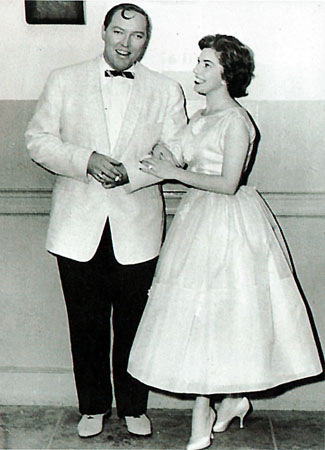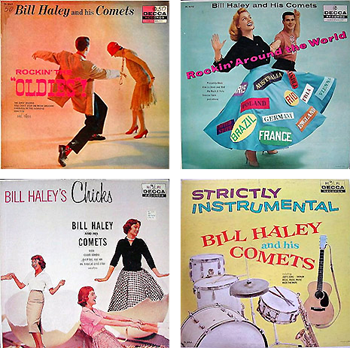Introduction to BILL HALEY:
The Man Who Turned Jump Blues Into Rock ’n Roll
by David Gasten
 |
Too cute! Bill Haley with a lovely, beaming fan club secretary on his arm. |
“One, Two, Three O’ Clock, Four O’ Clock, Rock…” Bill Haley and His Comets’ “Rock Around The Clock” kicked off the worldwide musical phenomenon we now know as Rock ’n Roll. The story leading up to “Rock Around the Clock” follows a man developing an exciting new musical sound, with explosive results that have long since dwarfed the man who detonated the bomb.
Why did Rock ’n Roll leave Bill Haley behind? Read on to find out…
Background: Jump Blues Was the Predecessor to Rock ’n Roll
People seem to forget that Rock ’n Roll began as a hybrid genre. To really understand early Rock ’n Roll, you need to trace it back to the pure music form that it branched off of, which was Jump Blues. For some reason nobody wants to do this, preferring instead to debate what the first Rock ’n Roll performer or song was. My personal opinion as to why this is is that people are essentially obsessed with Rock ‘n Roll and Rock Music in general as though music didn’t exist before it. John Lennon made the statement, “Before there was Elvis Presley, there was nothing”, and I think this is representative of the very attitude that the vast majority of music listeners today have. So, mistakenly believing that Rock ’n Roll was born as a distinct genre, they take this mindset with them when they work as amateur (or even professional) musicologists. But when you examine the developments in Jump Blues as the true beginning of intensity in pop music, all of a sudden the pieces come together more easily, and the story of the birth of Rock ’n Roll makes a lot more sense.
When people try to figure out what the first Rock ’n Roll record was, what they are really asking is, “Where did intensity in pop music as we know it today come from?” This latter question we have an answer to. We can trace the introduction of modern-day intensity in pop music to Wynonie Harris’ single “Good Rockin’ Tonight”, which stayed in the Top Ten on the R&B charts for six months in 1948, permanently raising the noise level in Jump Blues and R&B music in general in the process.
From Western Swing to Jump Blues
Bill Haley & the Saddlemen starting their transition from Western Swing to Jump Blues with the song "Rocket 88" (1951). Originally released on the Holiday Reocrds, Essex Records rereleased "Rocket 88" as a single the following year in 1952. Here the song is lifted from The Best of Bill Haley and His Comets 1951-1954, a well-mastered and highly recommended CD compilation of Haley's pre-"Rock Around the Clock" material. |
The original performer to successfully incorporate the feel of intense Jump Blues into general popular culture was none other than the great Bill Haley. Haley had initially gained popularity with his five-piece Western Swing band Bill Haley and The Saddlemen, who were active in the late 1940’s and very early 1950’s. There was a trend in that period were many Country & Western performers would cover Jump Blues recordings, and in this way Jump Blues songs would successfully cross over into the country charts. However, whenever this happened, they would always end up sounding like country songs, not like Jump Blues songs. Bill Haley and The Saddlemen, on the other hand, had a natural feel for Jump Blues, and managed to successfully incorporate that into their versions of Jump Blues songs. Haley’s first such jump blues/country single was a cover of the Jackie Brenston song “Rocket 88” in 1951 on the independent Holiday Records label. This song serves as the beginning of Haley’s transition from Western Swing bandleader to the creator of the hybrid music now known as Rock ’n Roll.
Haley signed a contract with Essex Records in 1951. One jump blues song Haley released on Essex was a cover Jimmy Preston’s incredibly intense 1949 R&B hit “Rock the Joint”. Haley’s version was released in 1952. The song caught on, apparently selling 150,000 copies. Haley's “Rock This Joint” turned out to be a trial run for “Rock Around the Clock”, with its guitar solo being reproduced note-for-note in “Rock Around the Clock”.
During this period, Haley knew he was onto something, and constantly worked on and developed the band’s sound. According to the liner notes of the Bear Family Record box set The Decca Years and More, one of his band members, Billy Williamson, said, “Haley was like a scientist putting one thing after another into a test tube, and he’d be so happy when one experiment turned out right.” As the sound developed, the band found an audience at teen dances and, because the music was straying so far from western swing, they changed their name from Bill Haley and the Saddlemen to Bill Haley and His Comets, a wordplay on Halley’s Comet. In keeping with their new direction, they did away with their cowboy hats and changed their wardrobe to more urban attire. Haley’s next hit single would be “Crazy Man Crazy”, which was written in response to one teenage fan’s description of Haley’s music. “Crazy Man Crazy” easily outperformed “Rock This Joint”, hitting #12 on the pop charts in 1953.
“Rock Around The Clock”: The Shot Heard ’Round the World
Bill Haley & His Comets performing "Rock Around the Clock" on The Dick Clark Show in 1960. |
In 1954, Haley switched from Essex Records to Decca Records, former home of Jump Blues/R&B legend Louis Jordan. Haley’s very first single for Decca, “Thirteen Women” b/w “Rock Around the Clock”, would be The Shot Heard ‘Round The World, but the shot took longer to be heard than most people realize. Initially, “Thirteen Women” was the A-side of this single, and “Rock Around the Clock” was the B-side. It was released on May 10, 1954, and sold modestly but well. In the meantime, Haley covered another Jump Blues hit, “Shake Rattle and Roll” by Big Joe Turner, which performed decently. He then recorded “Dim, Dim the Lights”, which would become a hit on the R&B charts.
“Rock Around the Clock” was subsequently used in the opening credits of the teen movie Blackboard Jungle, which was released in March 1955 and quickly became a hit. The inclusion of “Rock Around the Clock” in Blackboard Jungle created a new demand for the song, and prompted Decca to re-release and re-promote the single, with “Rock Around the Clock” as the A-side and “Thirteen Women” as the B-side. The song became a #1 hit in June 5, 1955, and a massive hit all over the world.
Life After “Rock Around the Clock”
Unfortunately for Haley, the massive, landmark success of “Rock Around the Clock” would be the pinnacle of his career. After Haley had hit the right formula and struck gold with it, he insisted on keeping with the formula as other performers developed it into a meaner and more menacing sound immediately afterward, and then into a sweeter, poppier and even more teen-focused sound later in the decade. Because Haley stuck with the original formula and didn’t change it, his subsequent records in the 1950’s are essentially retreads and thematic takes on the “Rock Around the Clock” sound.
Haley’s Four Theme Albums
 |
Bill Haley's four theme albums: Rockin’ The Oldies (1957), Rockin’ Around the World (1958), Bill Haley’s Chicks (1959), and Strictly Instrumental (1959). |
A very little known fact about Bill Haley is that after the success of “Rock Around the Clock”, he released a series of four theme LP’s that present the Haley Rock ’n Roll sound in different contexts. The first is Rockin’ the Oldies (1957), a relatively decent album that features classic songs from the 1920’s through 1940’s such as “The Dipsy Doodle,” “Moon Over Miami”, and “Ain’t Misbehavin’” in a Rock ’n Roll style. After that, he released the abysmally bad Rockin’ Around the World (1958), which tries to take Rock ’n Roll international with songs such as “Piccadilly Rock” (which borrows from the tune of “London Bridge is Falling Down”), “Vive Le Rock ’n Roll” (featuring the tune of “Frère Jacques”), “Rockin’ Rollin’ Schnitzelbank”, and “El Rocko.” It’s every bit as embarrassing and painful to listen to as it sounds like it would be.
Haley then had a creative second wind in “Skinny Minnie”, which peaked at #22 on the charts and inspired another theme LP with songs about girls entitled Bill Haley’s Chicks (1959). The entire album is quite good, and tracks from the album such as “Skinny Minnie”, “Lean Jean”, and “Corrine, Corrina” show up on compilations from time to time. After this, Haley had a minor hit with the excellent instrumental “Joey’s Song”, which peaked at #46. “Joey’s Song” ended up being the inspiration for the final theme LP, Strictly Instrumental (1959). Strictly Instrumental is a fantastic diversion from the Rock ’n Roll sound into Bachelor Pad Music. One of the tracks from the album, “Skokiaan (South Africa Song)”, peaked at #70 and became Haley’s final US hit. Strictly Instrumental is ridiculously hard to find, but definitely worth seeking out for fans of the Bachelor Pad Music genre.
Decca Records dropped Haley in 1959, and Warner Brothers picked up Haley for what turned out to be an unsuccessful pairing. Haley’s popularity left The United States and went south to Mexico, where he recorded in the Spanish language for Odeon Records and became known as the “King of the Twist”. He even ended up moving to Mexico for a time due to his popularity there. His international following and later the oldies circuit would prove to be faithful to him for the rest of his life, but his subsequent recurrences on the American and British charts would only be revivals of “Rock Around the Clock”. Haley died February 9, 1981 in his retirement home in Harlingen, Texas, at the age of 55.
Bill Haley’s Original Comets (aka The Jodimars) Rock On
The Jodimars (later Bill Haley's Original Comets) performing "Let's All Rock Together" in 1955. |
There’s even more to the story. There was a great Bill Haley spinoff band that was active from 1955 to 1958 called The Jodimars. Their core members, Joey D’Ambrosino, Dick Richards, and Marshall Lytle, are essentially half of the “Rock Around the Clock” period Comets, and the name “Jodimars” is an amalgam of the first letters of their first names. D’Ambrosino, Richards, and Lytle left the Comets to form The Jodimars after Haley’s manager refused to give them a raise, and released eight singles altogether, six of which were with Capitol Records. The Jodimars’ songs are punchy, consistently high in quality, and more in line with the rockabilly sound that came after Haley's initial success. Although The Jodimars were a failure commercially, their music has seen several reissues, the longest running being the LP Well Now Dig This (1970). The Beatles even covered one of their songs, “Clarabella”, for the sessions that ended up becoming their posthumous 1994 double-album Live At the BBC.
In 1987, D’Ambrosino, Richards, and Lytle would join other “Rock Around the Clock”-period Comets Johnny Grande and Franny Beecher to form Bill Haley’s Original Comets, which is now one of the longest consistently running band reunions/nostalgia acts in rock music's history. Franny has since retired from the group, and Johnny Grande and Marshall Lytle passed away in 2006 and 2013 respectively, but the core members of the Jodimars continue on as the Original Comets to this day.
Resources:
Bill Haley Biography at billhaley.co.uk
Chris Gardner’s Comprehensive Bill Haley Discography
Shorter Discography (complete though 1964) at Rockin’ Country Style
Links to More Bill Haley Sites










